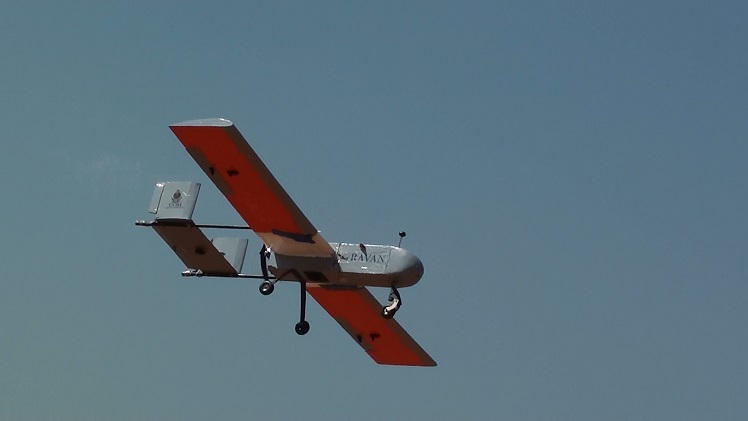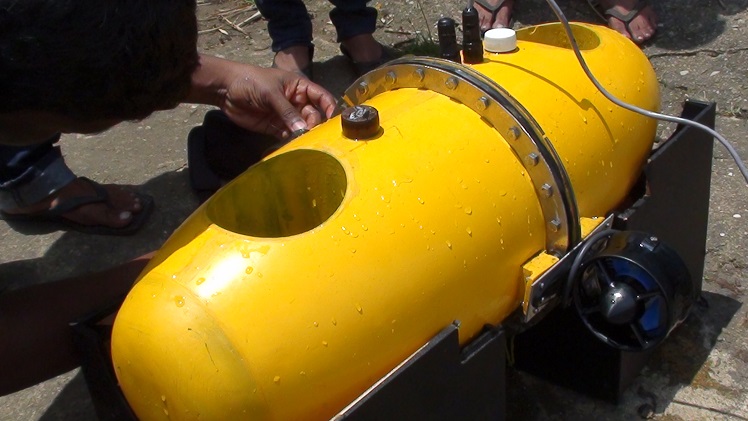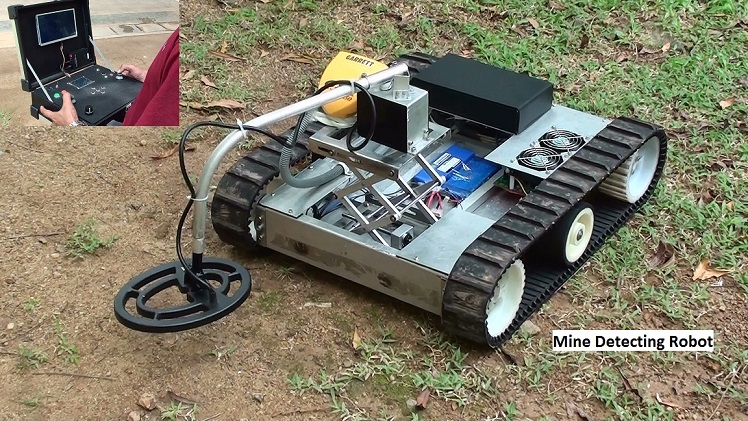Drones play a pretty important role in the world we see today – although few of us have ever actually seen one in the flesh, almost everyone on the Internet knows they exist. From UAVs like the General Atomics MQ-1 Predator (a product of the United States Air Force) to science fiction from Interstellar, drones are pretty much a part of the modern public consciousness.
But what’s Sri Lanka been doing in this field?
To answer that question, we decided to talk to Professor Rohan Munasinghe of the Department of Electronic and Telecommunication Engineering in the Faculty of Engineering of – pauses for breath – the University of Moratuwa. Armed with my laptop and Yudhanjaya’s camera, I made my way over to the University. Upon entering, I was told that photography is strictly forbidden within University premises, so I had to surrender the camera at the security post (much to my dismay). So before we begin – yes, we’ve got photos in this post, but they’re not ours.
Professor Rohan Munasinghe has mostly been a person we’ve seen at conferences and events, giving incredibly detailed speeches about robotics. He works from an office plastered with diagrams, surrounded by model robots. “Robots are the future,” he stated flatly, once the small talk was done with. Unlike most people who see robots primarily as a means of automating certain tasks, he sees them a something you can develop, sell to foreign markets – he’s quite adamant on this – and drive the economy with.
So…meet RAVAN.
RAVAN is a UAV – an Unmanned Aerial Vehicle. It weights 7.8kg and has a flight ceiling of approximately 300 meters. It was first flight tested for aerodynamic stability on the 2nd of February 2014, and then autopiloted on the 6th of July 2014. Thus far, RAVAN has undergone more than sixty flight tests without a single crash incident. Testing a UAV is no easy task – different speeds, altitudes, turn angles and many more variables have to be configured and fine-tuned in order to achieve the perfect flight. They’re been working on Ravan for two years now, and this drone has achieved a stable flight.

It all started back in 2007, when the University of Moratuwa first introduced Robotics as a subject to the Engineering syllabus. The initial start was slow, taking a few years to establish. But eventually, laboratories were built and the necessary equipment was put into place – the faculty even credits itself for hosting the first ever robotics competition in Sri Lanka among undergraduates.
Professor Munasinghe recalls that told me that it took him 2 years to start this robotics competition: it was a concept foreign to those following the engineering program in the University, and it actually had to take the form of a subject in syllabus. Students attended lectures, sat for exams, and on top of that, had to design and build a working robot at the end of the semester. The completed robot would then be entered into a competition and graded like a final project.
Everybody expected it to flop, but to the faculty’s surprise, students like it. For once they had a shot at breaking out of the traditional structure. Eventually, the program became one of the most popular in the University: it’s a grind that takes a high level of commitment to get through.
The next milestone was to introduce the concept of aerial robots to the syllabus – a whole different ball game. The faculty carried out a series of small to test the feasibility of adding the concept to the program, and by 2010, the Professor was confident that UAVs could be designed and developed in Sri Lanka. Support from the University and the rest of the faculty kicked in.
Aerial vehicles, he explains, were a whole different ball game. There were added risks – for example, if a drone crashes, the student fails. It would be much easier for a student just to follow the regular track. In order to compensate for any failures, the faculty had to minimize risk of something going wrong with the students projects – initial models could be repaired easily and be up and running within 30 minutes. After all, risks are not something the University can afford: they have limited funding. If something goes wrong, it essentially means a setback of at least 3 to 4 months of work. Meticulous care has to be taken before any kind of flight.
And then came CeyHawk
Eventually, Professor Munasinghe and his students in the faculty felt that they had reached a level where they could realistically build something that a hardcore hobbyist would like – more importantly, something that might make it in a global market.
The result was CeyHawk: a drone that is slightly smaller than RAVAN, better looking, with the fuselage shaped like a fish and the wings having a slight curvature to them – for aerodynamic stability, the Professor explained. Missing the camera, I asked him for more details on the production process. The explanation sounds easy: a 3D model is first created using applications such as Solidworks, then a cross section of each component is taken, and the components are laser-cut: from there, the auto pilot control system, video/data links and so on are all hardwired into the UAV. The exact process here is a bit more detailed, but that’s the gist of it.
CeyHawk was launched in December 2014, alongside with the inaugural opening of the UAV research lab in the faculty. This was the first laboratory dedicated to UAVs and drones, a first in the history of universities in Sri Lanka. Professor Munasinghe mentioned Professor A.K.W. Jayawardane, the Vice Chanceller, and Prof. U.G.A. Puswewala, the Dean of Faculty of Engineering were behind, whose support was critical in making all of this happen. Then, after permission from the the Civil Aviation Authority, SLAF and Sri Lanka Police, they were good to go.

The maiden flight of CeyHawk was done on the 8th of February. Most newly developed UAVs crash on the first flight; CeyHawk didn’t.
Now, says the Professor, they’ve got to a stage where the work they do supersedes a graduate level project and goes into post graduate territory. Perhaps now they can start chipping away at that hobbyist market.
Through earth, sky and water
We went there for drones, but apparently that’s not all this faculty is doing. The yellow thing in the photo below is an unmanned submarine of sorts. It’s around 3 feet long and is currently undergoing testing in the Bolgoda Lake, and apparently began with a post graduate student, and was and then passed down to a set of final year students.

And then there’s this:

This robot is a mine detector: they’re building it for the military. But the Professor is concerned with industrial robotics, a topic more at home in Japan than in Sri Lanka. The faculty aims, he says, to teach those interested so that in the future, there will be engineers in Sri Lanka who possess the knowledge and skill required to utilize industrial robots.
“Companies such as Festo, Farnook and Denzo manufacture and sell industrial robots. The idea is to learn from these companies and design and build our own: this is the way forward for Sri Lanka.”
Right now, the University is the main funding force behind all of this: the Mine Detector has received some funding from the Government of Sri Lanka and the NERD (National Engineering and Research) Center, and the rest is mostly on University payroll. For now, Professor Munasinghe and with his students are obsessed with perfecting the underwater robot, and putting CeyHawk into the global market. Let’s hope they can keep up the good work.





I hope this is not another publicity stunt like “Vega the supercar”
Whether it is a publicity stunt or not..they have at least tried to do a different ( difficult) thing rather than criticizing on every damn project
keep your head buried in the sand and you will miss everything around you.
at Kaveen – Vega the supercar is not a publicity stunt.You must visit the trace expert city to findout what is happenning there.And you can come to the moratuwa university too if you have any doubts what they are doing.
Kaveen: People fear and insult what they don’t understand.
Project vega is a joke and only idiots keep faith in it. Not sure about these childish looking gadgets though.
Warning! Trolls found in this area. Proceed with caution.
PS : Please don’t feed the trolls.
Thank You
Our dumbass UoM “engineers” are the biggest trolls ever. Coming up with silly DIY projects as freaking PHD researches and making noise in local media. Godayanta magic 😛
These are undergraduate projects, not MPhil, or PhD research. And, this is not DIY toy. Its a medium scale UAV. The autopilot (electronic control system) is the main piece developed by our students. It is in fact the first such development in Sri Lanka.
This project took over 8 years and several millions of Rupees. Most of that money went as fees to Prof Munasinghe and his staff. This kind of toy air planes are available in the market for few 100$. One need to be careful when academics claim research success of this type.
i dont beleive some of tne crap that comes out of empty heads.
get a life look forward and not backwards.
it is experiments for future innovations.
then again that may be beyond your comprehension.
^ Bla bla bla 😛
Hello jay .
You are ridiculous and idiotic , your statement is inferior . first place , you have forgot about how the westerners invented primarily almost every thing we use today , there weren’t any thing that has come without it begins from zero ,in there I accept why if some thing is already available for 100$ why should we bother to spend lot money for such a project . Which has a sense ,but do not forget that we need to be in touch as well .it doesn’t say as we can buy what we want from other country that we must not tend to make them which is wrong . We must involve into technology where we may be able to create some thing else new .
We started UAV development only three years ago, not 8 years. You must be referring to a different project, please check your info. In University projects, funds come from Senate research Committee, and no room for supervisor to get paid. Fees paid to Prof. Munasinghe is Rs. 0.
Prof. Munasinghe involved in another outside moratuwa UAV project, which started about 8 years ago (you must be referring to that project), and quit that project three years ago. He received Rs. 0 from that project. No one in the University has received any money from that project. We do a volunteer service, and we are happy about it.
Wisdom is all wealth !
It took you 3 freaking years to build this toy??? :O
These inventions are beyond the understanding of many of us and therefore, some amongst us ridicule such projects, without admitting its beyond their capacity to understand the application of such advanced science.
Keep going professor, you will succeed, if no one blocks it, especially if one of these sceptics become a Minister in the Government. However, my worry is that drones like this could be lethal in the hands of terrorists, if sold in the open market.
lol
We did build RF controlled planes way back in 90’s (in O/L grade) powered by RC 55AX 2 stroke engines front end driven to the propeller, fuel were used castor and ether mixed. It was illegal / difficult to fly then cos of LTTE conflicts, we tried these in Rajagiriya grounds, structure was made by thin plywood built vintage type models…it was our hobby then.
Typical Srilankan backword mentality..instead of supporting or sending funds to this Univercity every one is MUDSLINGING at this project..Everything start with ZERO ..and then u develop it ..MY HAT OFF TO THIS UNIVERCITY.and all the STAFF..I am willing to buy at least 20 UNDERWATER robots…as I can afford it
I don’t believe in blindly supporting trolls, which is unfortunately what most Sri Lankans are used to. Encouraging these kind of jokes (including and especially project Vega) only drive the country backwards, not forwards.
BE POSITIVE….KEEP UP THE GOOD WORK….
Lets see if the students of Moratuwa University could make drones as these.
lol don’t worry they can’t. Talking is the ONLY thing they are good at, regardless how irrelevant and outdated their arguments are. Read some of these tyical “Mora” type comments n u’ll understand. 😉
එම ගොන් පාර්ට් එක ඔබ වෙත ගෙන ආවේ මෝරා ඉන්ජන් අනුග්රහයෙන් 😀